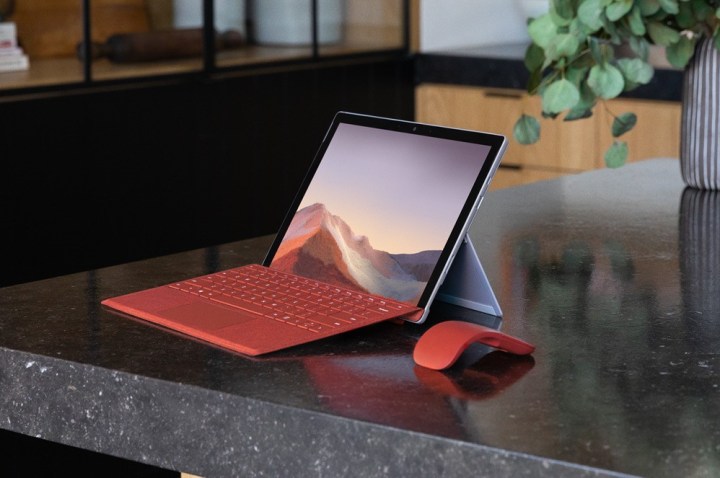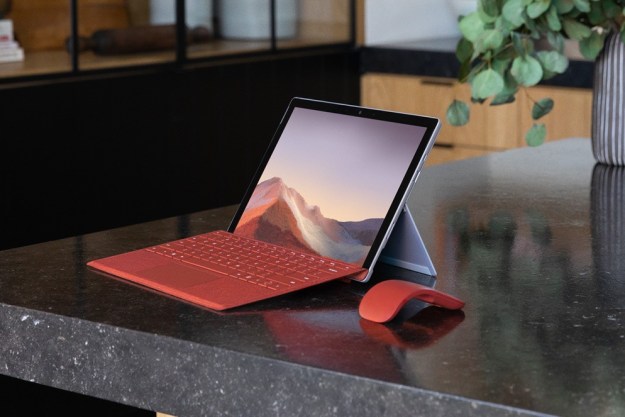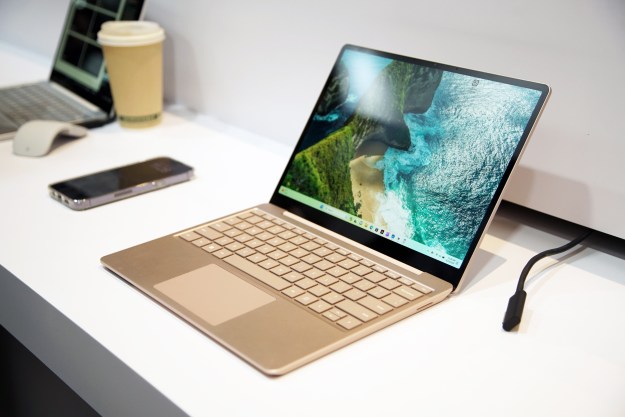
Although Apple’s iPad has traditionally been a tablet in almost every way, with some limited laptop functionality, the recent move to iPad OS has changed that. Productivity is on the rise and that makes it a serious contender for our favorite 2-in-1s, like Microsoft’s new Surface Pro 7. The question is, how do they compare when you really dig down into it?
To try to figure out which is best for you, we pitted the Apple iPad Pro versus Surface Pro 7 in a classic head-to-head.
Design
Microsoft’s new Surface Pro 7 doesn’t reinvent the wheel, but it does make some minor quality of life improvements which can build on its sterling legacy as our favorite 2-in-1. It has a similarly slim and lightweight design as its predecessors, whilst retaining a sturdy, robust feel. The bezels are still rather thick though, which is one area where the iPad Pro looks far more modern.
Apple made great strides in trimming the iPad Pro the last time it conducted a major revision and it’s even more noticeable when compared to the Surface Pro 7. Those slim bezels give plenty of room for the gorgeous display on the iPad Pro to flourish. The 12.9-inch version feels huge when holding it in hand, but it’s still lightweight enough to be manageable in both tablet and laptop mode.
The iPad Pro does suffer as a laptop replacement, however, due to the lackluster keyboard. Apple has faced difficulties with a number of its keyboard designs in recent years, and the latest Smart Keyboard is no different. There isn’t much of a satisfying feel to keys as you depress them, and considering the cost ($180 for the 11-inch iPad Pro keyboard, $200 for the 12.9-inch version), it’s a lot to ask for a passable typing experience.
As with most other devices in Microsoft’s Surface range, the keyboard for the Pro 7 is far better. We found both it and the touchpad to be great additions to the device, and with the type cover costing $130 or $160, depending on your color preference, it’s more affordable and easier to recommend. The same goes for Microsoft’s Surface Pen, which is $100 from Microsoft, where Apple’s Pencil is $130.
Port selection on both devices are quite different. The Surface Pro 7 finally added USB-C to its classic makeup of USB-A port, a MicroSDXC card reader, and a 3.5mm headphone jack. The iPad Pro made the controversial move of ditching the 3.5mm headphone jack, relying entirely on a USB-C connection for everything. That’s the extent of its ports too. Just one USB-C 3.2 Gen 2. It doesn’t have Thunderbolt 3 support either.
Software is a major difference between the two platforms. The Microsoft Surface Pro 7 uses Windows 10 as its base, offering a full-fat Windows experience with whatever apps the user wants to install from any developer. Apple’s iPadOS is much more versatile than the iOS of older iPads and is fluid enough that it could act as a relatively capable laptop if you wanted that sort of function. But Microsoft’s environment still offers a more versatile experience with a greater array of available software options
Performance

Starting at $999, the 12.9-inch iPad Pro comes with an Apple A12X Bionic chip with its embedded M12 coprocessor, 4GB of RAM, and 64GB of onboard eMMC flash storage. Options include 256GB, 512GB, and 1TB of SSD space, the most expensive of which bumps the cost up to $1,550, or $1,700 if you include cellular data connection. The 1TB version also comes with 6GB of RAM.
That’s a capable hardware lineup that should provide excellent performance in short bursts and reasonable performance over more protracted periods due to thermal throttling.
The Surface Pro 7 starts at just $750 with an Intel 10th-generation Ice Lake Core i3-1005G1 processor, 4GB of RAM, and 128GB of SSD storage space. For $900, you can upgrade to 8GB and a Core i5, which also uprates the graphics from Intel’s relatively pedestrian UHD to its 11th-generation Iris Plus, which are far more capable of entry-level gaming and 3D rendering.
There are options throughout the price range for up to 16GB of RAM, a Core i7 10th-generation processor and up to a terabyte of storage space. The top configuration will set you back $2,300.
Display-wise, the iPad Pro features Apple’s gorgeous Retina design with a resolution of 2,732 x 2,048, up to 600 nits of brightness, and a wide color gamut support. Frankly, it’s one of the best displays we’ve ever seen. It looks super smooth with its 120Hz refresh rate and everything from whites to even muted colors, just pop off the screen.
The Surface Pro 7 is no slouch though. Its 12.3-inch screen has a resolution of 2,736 x 1,824 which is lower than the iPad Pro’s but due to the slightly smaller screen, it actually has a minutely greater pixel density. It’s also vibrant and has great contrast, but we’ll have to get it in our testing labs to know for sure how it measures up.
The lower entry-level price of the Surface Pro 7 is attractive, especially considering its better memory and storage options. Graphically, the iPad Pro is far more capable than the Core i3 with UHD graphic model of the Pro 7, but Intel’s new Ice Lake processors should give the Apple device a run for its money and the top configuration should outstrip the iPad Pro in sustained usage like gaming.
Portability
The iPad Pro measures 11.04 x 8.46 x 0.23 inches and weighs just 1.4 pounds with the cellular connectivity add-on. The Surface Pro 7 measures 11.5 x 7.9 x 0.33 inches, so is very comparable, but slightly bulkier. That’s reflected in its weight, which is 1.74 pounds with its most capable hardware options. That’s not a big enough difference to really notice, but if weight and size are absolutely your most important considerations, the iPad Pro is the more svelte device.
As for battery life, the iPad Pro is said to last for up to 10 hours with its 36.71 watt-hour battery, where the Surface Pro 7 can reportedly last 10.5 hours. We haven’t had a chance to test either of these devices in our labs, so we can’t say for sure, but they should be pretty comparable. Apple is typically honest with its battery life claims and Microsoft’s Surface devices usually offer excellent battery life. Neither device should have any trouble getting you through a workday.
Surface Pro 7 scrapes a win
This is a head-to-head where the end result is almost too close to call. Hardware makeups are stellar in both, with fantastic displays and powerful new processors and graphics. Both have USB-C ports for modern connectivity options, and neither device is hefty nor lacking in battery life. But a few of the Surface Pro 7’s strengths keep it ahead of Apple’s best iPad Pro yet.
A broader selection of, and more ports to pick from, make the Surface Pro 7 a more versatile device. If you plan to plug in any selection of accessories to your iPad Pro, you will have to buy an adapter. The lack of a 3.5mm headphone jack seems rather unnecessary. Especially since Microsoft managed to maintain it and more in a device with a near-identical physical form.
The keyboard in the Surface Pro 7 is much better, and a cheaper accessory to boot. Especially when you consider that its base-model is several hundred dollars cheaper than Apple’s.
But the iPad Pro is excellent. If you’re an Apple fan, it could well replace your Mac or MacBook if you don’t mind sacrificing some of the functionality of MacOS. But the Surface Pro 7 is far more versatile. It’s not a better tablet, but it’s a better 2-in-1 and when that’s a major selling point of your device, it plays a major role in what is the best of the two devices.
Editors' Recommendations
- Surface Pro 10: all the major changes rumored for the new model
- Best Lenovo laptop deals: Save on Yoga and ThinkPad laptops
- Best Apple deals: Save on AirPods, Apple Watch, iPad, MacBook
- The best laptops for music production, chosen by experts
- This genius app turns your iPad into a Mac drawing tablet




